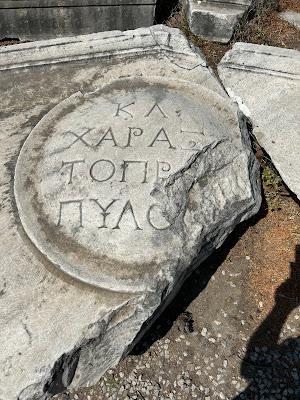"And to the angel of the church in Pergamum write 'The words of him who has the sharp two-edged sword./" - The Revelation to John (The Apocalypse) Chapter 2, verse 12
The Kingdom of Pergamon (Pergamum) originated as the city of Pergamos, which we have attestation to in Classical Greek times through Xenophon's Anabasis. Its rise as a kingdom dates to the period following the Wars of the Diadochi (The successors of Alexander the Great), when a lieutenant of the general Lysimachus founded the Attalid dynasty, which declared itself a kingdom after the victory of Attalus I in 238 B.C. over the Galatians, a Celtic force that had made its way all the way to central Anatolia (and, by the way, gave us the book of Galatians in The Bible).
 |
| Kingdom of Pergamon circa 188 B.C. (Source) |
The Attalids sought to build a city that was in no way inferior to Athens. Their library became the second biggest of the Ancient World after The Library of Alexandria; their city was remodeled to resemble Athens with temples and theaters. Placed above a mesa overlooking a valley, it was undoubtedly an imposing sight (it is still so, today). We have, oddly enough, met the Attalid dynasty before: The Stoa of Attalos in Athens, built in the mid 2nd Century B.C., was put in place by the King of Pergamon Attaos II.
In 133 B.C., the last king of the Attalid dynasty Attalus (Attalos) III died without heir. He willed the kingdom to the Roman Republic, where it became a province of the Empire and the core of the Roman Province of Asia. The city continued to exist until the 1200's A.D., when invading Turks finally pushed the city into ruins to be plundered.
(Somewhat sadly, the Acropolis of Pergamon is only accessible by a road which our coach would not fit on and a gondola which does not run on windy days - of which this was one. If I am able to return to see these ruins, I would happily do so.)
Fortunately for the rest of us, there is still plenty to see: Pergamon is the site of an Askeplieion.
An Asklepieion was a temple devoted to Asklepius, considered a demi-god who was the first doctor in Greek history. It was said of him that he could raise the dead. At the request of Hades, God of the Underworld, who was bothered by the fact that Asklepius was cutting into the bottom line, he was slain by Zeus but at Apollo's request was raised to be immortal.
There were multiple Asklepieions throughout the ancient world; over 300 hundred ruins have been found. The structure of them appears to be roughly the same: A temple where the God was worshipped and where the sick would sleep in hopes of a having a dream that they would share with a priest, who would try to interpret the dream for the symptoms and recommend a cure (perhaps baths, exercise, or diet), and quarters for the priests, doctors, and patients (the physicians of Greece were well known and sought after in both the Greek and Roman worlds).
The physician Galen (A.D. 129 -216), who served several Roman Emperors in his day, was a product of the Asklepieion of Pergamon.
Patients and benefactors would make cash donatives as thanks for their healing, thus endowing the location with these fine ruins.
A reconstructed wall:
The fact that I can recognize these as Greek letters thousands of years later never ceases to amaze me.













It's those Celts. I didn't know they had made it as far as Asia Minor. So interesting to get some history. Can definitely see the Greek influence.
ReplyDeleteClarification: You wrote "Attalus (Attalos) III died with heir. He willed the kingdom to the Roman Republic." Should that be without heir? I'm thinking his heirs would have made a fuss over not inheriting his kingdom.
The city was completely destroyed? Is there a modern remnant?
Leigh - Yes, in fact it was "without heirs"; thanks for catching it. There was someone that (of course) claimed to be his son, but the revolt never really went anywhere.
DeleteThe Gallic invasion of the Balkans and ultimately Anatolia is another one of those crazy historical things we never read much about. Starting in 280 B.C., the Celts invaded through Balkans into Greece (actually fighting a battle at Thermopylae and reaching as far South as Delphi, where a thunderstorm which of was, of course, brought by the Gods, threw them back). A sub-group of this reached into Anatolia. Even as late as the Sixth Century A.D., the inhabitants still spoke what likely we would call Gaulish.
If you have ever seen a statue labeled The Dying Gaul, this is a Roman copy of Greek original commissioned by Attalos I to commemorate his victory over the Gauls between 240 and 230 B.C>
Very interesting TB, even back then doctors didn't make house calls..... :)
ReplyDeleteNylon12, I have to admit I was rather shocked at what was presented in terms of the course of treatment - sure, maybe we do not sleep in temples looking for dreams to interpret (although maybe modern psychology is akin to this?), but the rest of it sounded relatively modern. Crazy how advanced those dead civilizations were...
Delete